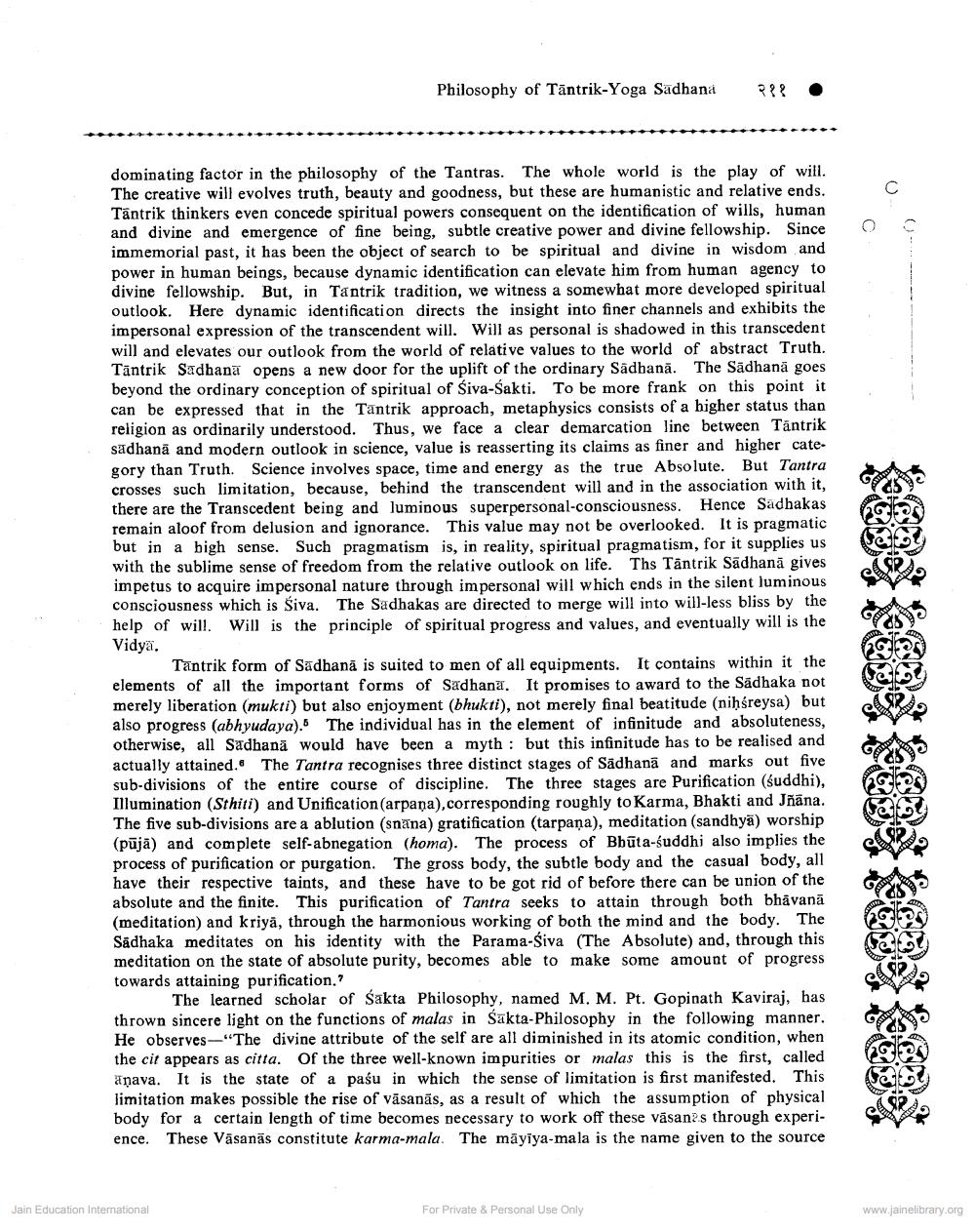Book Title: Philosophy of Tantrik Yoga Sadhna Author(s): Vaishishtha Narain Tripathi Publisher: Z_Pushkarmuni_Abhinandan_Granth_012012.pdf View full book textPage 2
________________ Philosophy of Tāntrik-Yoga Sadhana PP? • dominating factor in the philosophy of the Tantras. The whole world is the play of will. The creative will evolves truth, beauty and goodness, but these are humanistic and relative ends. Tantrik thinkers even concede spiritual powers consequent on the identification of wills, human and divine and emergence of fine being, subtle creative power and divine fellowship. Since immemorial past, it has been the object of search to be spiritual and divine in wisdom and power in human beings, because dynamic identification can elevate him from human agency to divine fellowship. But, in Tantrik tradition, we witness a somewhat more developed spiritual outlook. Here dynamic identification directs the insight into finer channels and exhibits the impersonal expression of the transcendent will. Will as personal is shadowed in this transcedent will and elevates our outlook from the world of relative values to the world of abstract Truth. Tantrik Sadhana opens a new door for the uplift of the ordinary Sadhanā. The Sadhanā goes beyond the ordinary conception of spiritual of Siva-Sakti. To be more frank on this point it can be expressed that in the Tantrik approach, metaphysics consists of a higher status than religion as ordinarily understood. Thus, we face a clear demarcation line between Tantrik sadhana and modern outlook in science, value is reasserting its claims as finer and higher category than Truth. Science involves space, time and energy as the true Absolute. But Tantra crosses such limitation, because, behind the transcendent will and in the association with it, there are the Transcedent being and luminous superpersonal-consciousness. Hence Sadhakas remain aloof from delusion and ignorance. This value may not be overlooked. It is pragmatic but in a high sense. Such pragmatism is, in reality, spiritual pragmatism, for it supplies us with the sublime sense of freedom from the relative outlook on life. Ths Tantrik Sadhanā gives impetus to acquire impersonal nature through impersonal will which ends in the silent luminous consciousness which is Siva. The Sadhakas are directed to merge will into will-less bliss by the help of will. Will is the principle of spiritual progress and values, and eventually will is the Vidya. Tantrik form of Sadhanā is suited to men of all equipments. It contains within it the elements of all the important forms of Sadhana. It promises to award to the Sadhaka not merely liberation (mukti) but also enjoyment (bhukti), not merely final beatitude (niņśreysa) but also progress (abhyudaya). The individual has in the element of infinitude and absoluteness, otherwise, all Sadhana would have been a myth : but this infinitude has to be realised and actually attained. The Tantra recognises three distinct stages of Sadhana and marks out five sub-divisions of the entire course of discipline. The three stages are Purification (suddhi), Illumination (Sthiti) and Unification (arpana),corresponding roughly to Karma, Bhakti and Jñana. The five sub-divisions are a ablution (snana) gratification (tarpaņa), meditation (sandhyā) worship (pūjā) and complete self-abnegation (homa). The process of Bbūta-buddhi also implies the process of purification or purgation. The gross body, the subtle body and the casual body, all have their respective taints, and these have to be got rid of before there can be union of the absolute and the finite. This purification of Tantra seeks to attain through both bhāvanā (meditation) and kriya, through the harmonious working of both the mind and the body. The Sädhaka meditates on his identity with the Parama-Siva (The Absolute) and, through this meditation on the state of absolute purity, becomes able to make some amount of progress towards attaining purification.? The learned scholar of Sakta Philosophy, named M. M. Pt. Gopinath Kaviraj, has thrown sincere light on the functions of malas in Sakta-Philosophy in the following manner. He observes-"The divine attribute of the self are all diminished in its atomic condition, when the cit appears as citta. Of the three well-known impurities or malas this is the first, called anava. It is the state of a paśu in which the sense of limitation is first manifested. This limitation makes possible the rise of vāsanās, as a result of which the assumption of physical body for a certain length of time becomes necessary to work off these vāsanas through experience. These Vāsanās constitute karma-mala. The māyiya-mala is the name given to the source Jain Education International For Private & Personal Use Only www.jainelibrary.orgPage Navigation
1 2 3 4 5 6 7 8 9
